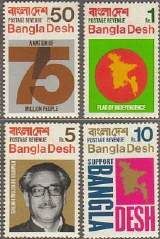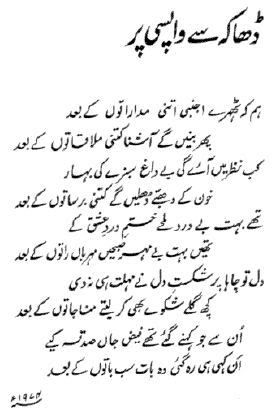Adil Najam
 As the fourth part of our series on the events of 1971, we are reposting this post which was first published at ATP on December 16, 2006. We are reposting it with all the original comments since they, as a whole, are very much part of the conversation we all need to have with ourselves. The previous three parts of the series can be read here, here and here.
As the fourth part of our series on the events of 1971, we are reposting this post which was first published at ATP on December 16, 2006. We are reposting it with all the original comments since they, as a whole, are very much part of the conversation we all need to have with ourselves. The previous three parts of the series can be read here, here and here.
Today is December 16.
Today Bangladesh will mark its 35th ‘Victory Day.’
 Most Pakistanis will go about their lives, not remembering or not wanting to remember. We should remember – and learn – from the significance of this date.
Most Pakistanis will go about their lives, not remembering or not wanting to remember. We should remember – and learn – from the significance of this date.
Not because it marks a ‘defeat’ but because it marks the end of a dream, 24 years of mistakes, horrible bloodshed, traumatic agony, and shameful atrocities. The constructed mythologies of what happened, why, and who is to be blamed need to be questioned. Tough questions have to be asked. And unpleasant answers have to be braced for. We need to honestly confront our own history, for our own sake.
But right now, the goal of this post is different. We at ATP just wish to extend a hand of friendship to our Bangladeshi friends. May the memories we make in our future be very different (and more pleasant) than the scars we carry from our past.
There is much – too much – that I wish to say; but cannot find words for. So let me do what I always do when I am at a loss of words. Let me quote Faiz Ahmad Faiz, who in his memorable 1974 poem ‘Dhaka say wapsi par’ (On Return from Dhaka) expressed what I wish to say so much better than I ever could.
We share with you here the original poem in Urdu, a version in ‘Roman Urdu,’ a wonderful English translation of the poem by the late Agha Shahid Ali in his book The Rebel’s Silhouette, and a video of Nayarra Noor singing the verses with the passion and feeling that they deserve.
ham ke Thehre ajnabi itni mulaaqaatoN ke baad
phir baneiN ge aashna kitni madaaraatoN ke baadkab nazar meiN aaye gi be daaGh sabze ki bahaar
khoon ke dhabe dhuleiN ge kitni barsaatoN ke baadthe bahut bedard lamhe khat’m-e-dard-e-ishq ke
theiN bahut bemeh’r subheiN meh’rbaaN raatoN ke baaddil to chaaha par shikast-e-dil ne moh’lat hi na di
kuchh gile shikwe bhi kar lete manaajaatoN ke baadun se jo kehne gaye the “Faiz” jaaN sadqe kiye
an kahi hi reh gayi woh baat sab baatoN ke baad
Agha Shahid Ali’s Translation:
After those many encounters, that easy intimacy,
. we are strangers now —
After how many meetings will we be that close again?When will we again see a spring of unstained green?
After how many monsoons will the blood be washed
. from the branches?So relentless was the end of love, so heartless —
After the nights of tenderness, the dawns were pitiless,
. so pitiless.And so crushed was the heart that though it wished
. it found no chance —
after the entreaties, after the despair — for us to
. quarrel once again as old friends.Faiz, what you’d gone to say, ready to offer everything,
. even your life —
those healing words remained unspoken after all else had
. been said.





















































Thnak you from a Bangladeshi on this nice essay. I cannot understand the Urdu in the poem but the translation was good.
One thing to think about is more trade between Bangladesh and Pakistan. This could benefit both countries and improve relations.
Yes, Bhutto did visit Bangladesh in June of 1974, however, it was not before he tried arduously not to recognize Bangladesh. However, most countries did recognize Bangladesh and Bhutto had to capitulate eventually. Following is a small para of what Bangladesh went through after independence…
“…Rejecting Pakistan’s call for a reunited country, Sheikh Mujib began to rehabilitate an economy devastated by the war. Relations with Pakistan were hostile; Pakistan withheld recognition from Bangladesh, and Bangladesh and India refused to repatriate more than 90,000 Pakistani prisoners of war who had surrendered at the end of the conflict. Armed Bengali “freedom fighters” fought Bihari civilians in Bangladesh, particularly after Indian troops withdrew from Bangladesh in Mar., 1972.
Tensions were eased in July, 1972, when President Zulfikar Ali Bhutto Bhutto, of Pakistan (who assumed power after the fall of the Yahya Khan government) and Prime Minister Indira Gandhi Gandhi, Indira (ÄndÄ“`rÉ™ gän`dÄ“), 1917–84, Indian political leader; daughter of Jawaharlal Nehru . She served as an aide to her father, who was prime minister (1947–64), and as minister of information in the government of Shri Lal Bahadur Shastri (1964–66) of India agreed to peacefully settle the differences between their countries. Pakistan officially recognized Bangladesh in Feb., 1974. Subsequently, India and Pakistan reached consensus on the release of Pakistani prisoners of war and the exchange of hostage populations.”
Also, for those of you who believe that Musharraf has not apologised for the event please read the following:
“Pakistan President Pervez Musharraf during his visit to Bangladesh from 29-31 July 2002, also emphasised the need for opening a new era of friendship between the two countries and pointed out that the time for reconciliation had arrived. More significantly, he expressed regret at the 1971 events that agonised both sides.”
Enjoyed reading the post and comments. There are some factors that somehow have not been elaborated. First is the role to Urdu in flaring Bengali nationalism. Qaid-e-Azam, against the advice of Sir Agaha Kahn decided to make Urdu as a national language. Under democratic principles,Bengali could have easily become the national language. Sir Agha Khan’s argument was that since Pakistan is being made for Muslims, and considering the number of languages in different provinces, no one would object if Arabic was selected as the national language. The first sign of fissures in the federation appeared during agitations in E. Pak in the early 50s and were related to language. These emotions contiuned to simmer…
My father who served in E. Pak for a number years in the fifties and early sixties often mentioned that his Bengali friends sometimes joked that they won freedom from British only to become slaves of the US – simply stated, E. Pakistanis considered their counterpart in the W. Pak to be an extension of America – a correct assessment in view of the SETO, CENTO, and US AFB in Peshawar from where U2 used to fly to spy on USSR.
While a large numebr of Bengalis died regularly when hit by floods, economic deprivation only increased. East Paksitan was viewed in the WP as money pit. Federal budgets of that era are a good indicator of step-child approach. (By the way, only after independence, Bangladeshis started above ground construction in coastal areas and reduced the death rate.) Nevertheless, whenever E. Pakistani delegations visited West Pak, they were toured around in the modern city of Islamabad. The contrast between what they lived through in EP and extravaganza of the WP was very high. This lead to further alienation. If East Pakistanis visited katchi abadis or slums in Sindh, poverty stricken areas of Balochistan, and Frontier, they would have found a common denominator with their brothers in the West.
Some of my friends are of the view that it was a bad marriage but it takes two to mess things up.
Please go the the following web site… http://www.thebaluch.com/
It is distrubing. I hope our masters concentrated in few cities of Pakistan and their cheerleder “Danishwer” mafia don’t pull the same trick again.
I wish people of Bangladesh the very best. I have fond memories of my early schooling in Cantt Modern School, Dacca. Skies were clear and blue, clouds always were in a hurry, and when it rained, it rained as if it was chasing the guy running away from it – the beautiful wind, green ponds where I learned to catch a fish or two with a bamboo pole, stadium in the inner city where I first sat through a cricket match….not knowing what it was.
Mujeeb-ur-Rehman visited Pak in 1973 for the Lahore summit
By the way, this is a really wonderful English translation which captures the intent of the original verse. Specially:
So relentless was the end of love, so heartless –
After the nights of tenderness, the dawns were pitiless, so pitiless.